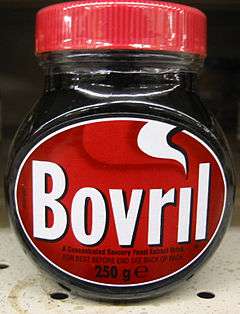Meat extract

Meat extract is highly concentrated meat stock, usually made from beef. It is used to add meat flavour in cooking, and to make broth for drinking.
Meat extract was invented by Baron Justus von Liebig, a German 19th-century organic chemist. Liebig specialised in chemistry and the classification of food and wrote a paper on how boiling meat destroys its nutritional value. Liebig's view was that meat juices, as well as the fibres, contained much important nutritional value and that these were lost by boiling or cooking in unenclosed vessels.[1] Fuelled by a desire to help feed the undernourished, in 1840 he developed a concentrated beef extract, Extractum carnis Liebig, to provide a nutritious meat substitute for those unable to afford the real thing. However, it took 30 kg of meat to produce 1 kg of extract, making the extract too expensive.
Commercialisation
Liebig's Extract of Meat Company
Liebig went on to co-found the Liebig's Extract of Meat Company, (later Oxo), in London whose factory, opened in 1865 in Fray Bentos port Uruguay, took advantage of meat from cattle being raised for their hides—at one third the price of British meat. Before that, it was the Giebert et Compagnie (April 1863).
Bovril
In the 1870s, John Lawson Johnston invented 'Johnston's Fluid Beef', later renamed Bovril. Unlike Liebig's meat extract, Bovril also contained flavourings. It was manufactured in Argentina and Uruguay which could provide cheap cattle.
Effects
Liebig and Bovril were important contributors to the beef industry in South America.
Today
Meat extracts have largely been supplanted by bouillon cubes and yeast extract. Some brands of meat extract, such as Oxo and Bovril, now contain yeast extract as well as meat extract. For example, the current formulation of Bovril contains 41% beef stock, 24% yeast extract, 1% dehydrated beef and salt (3.88g sodium per 100g), spice extracts and flavour enhancers among other ingredients.[2] High purity meat extract is still available from laboratory supply companies for microbiology.[3]
See also
References
- ↑ Brock, William H. (1997). Justus von Liebig : the chemical gatekeeper. Cambridge, U.K.: Cambridge University Press. pp. 218–219. ISBN 9780521562249.
- ↑ Justinevb (2 August 2013). "Bovril Beef Extract 125g (Product Information)". Ocado website. Ocado. Retrieved 22 June 2014.
- ↑ http://www.sigmaaldrich.com/catalog/product/sial/70164
Bibliography
- Günther Klaus Judel, "Die Geschichte von Liebigs Fleischextrakt: Zur populärsten Erfindung des berühmten Chemikers" (The History of Liebig's Meat Extract: On the famous chemist's most popular invention), Spiegel der Forschung: Wissenschaftsmagazin der Justus-Liebig-Universität Gießen 20:1/2:6, October 2003. (in German)PDF